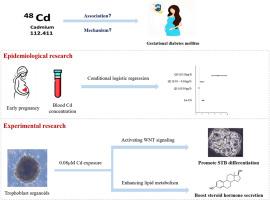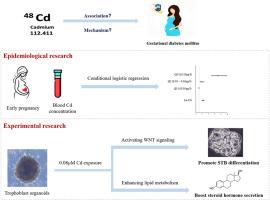低剂量镉暴露在妊娠期糖尿病发病机制中的作用
IF 7.3
2区 环境科学与生态学
Q1 ENVIRONMENTAL SCIENCES
引用次数: 0
摘要
妊娠期糖尿病(GDM)是由胰岛素抵抗激素与胰岛素分泌失衡引起的。产前镉(Cd)暴露与GDM之间的关系尚不清楚。此外,Cd如何导致GDM,特别是从胎盘发育的角度来看,在很大程度上是未知的。在这项研究中,我们旨在基于出生队列(462例GDM病例和924例匹配对照)确定血Cd浓度与GDM发病率的关系,并通过应用滋养细胞类器官和合胞滋养细胞(STB)模型揭示低剂量Cd在GDM发展中的机制。结果显示,妊娠早期GDM组和对照组的平均血浆Cd浓度分别为0.37和0.12μg/l, Cd浓度升高与GDM风险增加相关(优势比= 2.15;95%ci: 1.84, 2.50)。0.08μM Cd(研究队列中第95百分位血浆Cd浓度)促进STB中ACSM1基因的表达,促进线粒体中脂肪酸β氧化。Cd处理增加了线粒体呼吸能力,其主要燃料为葡萄糖。Cd处理的STB中胰岛素抵抗激素的合成升高,表明所产生的脂质底物不是或至少不是主要促进三羧酸循环,而是促进类固醇激素的产生,这可能促进GDM的发展。本文章由计算机程序翻译,如有差异,请以英文原文为准。


Role of low-dose cadmium exposure to the pathogenesis of gestational diabetes mellitus
Gestational diabetes mellitus (GDM) is caused by the imbalance between insulin-resistance hormones and insulin secretion. The association between prenatal cadmium (Cd) exposure and GDM remains unclear. Furthermore, how Cd contributes to GDM, especially in the perspective of placental development, is largely unknown. In this study, we aimed to define the association of blood Cd concentrations with GDM incidence based on a birth cohort (462 GDM cases and 924 matched controls), and unravel the mechanism of low-dose Cd in GDM development by applying trophoblast organoids and syncytiotrophoblasts (STB) models. The results showed that the mean plasma Cd concentration during early pregnancy for GDM cases and controls were 0.37 and 0.12μg/l, respectively, and increasing Cd concentrations were associated with an increased risk of GDM (odds ratio = 2.15; 95%CI: 1.84, 2.50). 0.08μM (the 95th percentile plasma Cd concentration of the study cohort) Cd promoted WNT signaling and ACSM1 gene expression in STB, which facilitate the STB differentiation and fatty acid beta oxidation in mitochondria, respectively. Mitochondrial respiration capacity was increased upon Cd treatment, the main fuel of which was glucose, Insulin-resistance hormone synthesis was elevated in Cd treated STB, indicating that the resulting lipid substrate did not, or at least not mainly contribute to tricarboxylic acid cycle, but to steroid hormone production, which might promote the GDM development.
求助全文
通过发布文献求助,成功后即可免费获取论文全文。
去求助
来源期刊

Environmental Pollution
环境科学-环境科学
CiteScore
16.00
自引率
6.70%
发文量
2082
审稿时长
2.9 months
期刊介绍:
Environmental Pollution is an international peer-reviewed journal that publishes high-quality research papers and review articles covering all aspects of environmental pollution and its impacts on ecosystems and human health.
Subject areas include, but are not limited to:
• Sources and occurrences of pollutants that are clearly defined and measured in environmental compartments, food and food-related items, and human bodies;
• Interlinks between contaminant exposure and biological, ecological, and human health effects, including those of climate change;
• Contaminants of emerging concerns (including but not limited to antibiotic resistant microorganisms or genes, microplastics/nanoplastics, electronic wastes, light, and noise) and/or their biological, ecological, or human health effects;
• Laboratory and field studies on the remediation/mitigation of environmental pollution via new techniques and with clear links to biological, ecological, or human health effects;
• Modeling of pollution processes, patterns, or trends that is of clear environmental and/or human health interest;
• New techniques that measure and examine environmental occurrences, transport, behavior, and effects of pollutants within the environment or the laboratory, provided that they can be clearly used to address problems within regional or global environmental compartments.
 求助内容:
求助内容: 应助结果提醒方式:
应助结果提醒方式:


